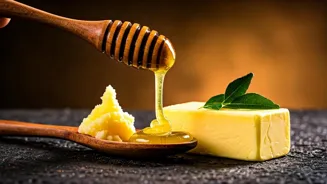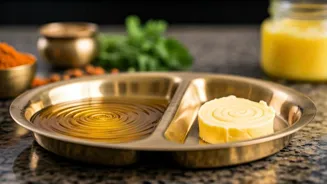When it comes to daily cooking and spreading, two dairy staples often spark debate, ghee and butter. Both originate from milk, but their nutritional composition, health impact, and culinary benefits vary,
making it important for adults to understand which suits their lifestyle better.
Nutritional Differences
Butter is made by churning cream and contains about 80% fat, along with small amounts of milk solids and water. It is rich in saturated fat and provides vitamins A, D, E, and K. However, because it still contains lactose and casein, it may not be ideal for those with dairy sensitivities.
Ghee, on the other hand, is clarified butter, milk solids and water are removed through slow heating. This makes ghee lactose- and casein-free, suitable for people with dairy intolerance. It also has a higher smoke point than butter, which makes it a safer choice for high-heat cooking like frying or sautéing. Nutritionally, ghee is a source of healthy fats and butyrate, a short-chain fatty acid linked to gut health.
Health Benefits and Concerns
Ghee has been celebrated in Ayurveda for centuries as a digestive aid and a source of energy. Its fat-soluble vitamins support immunity, brain function, and hormone balance. The presence of conjugated linoleic acid (CLA) in ghee may also help with heart health when consumed moderately.
Butter, while not inherently “bad,” needs to be consumed with more caution. Its higher cholesterol and saturated fat content can contribute to weight gain and cardiovascular risks if eaten in excess. However, grass-fed butter has beneficial omega-3 fatty acids and vitamin K2, which support bone and heart health.
Which Should Adults Choose Daily?
The choice largely depends on individual health goals and dietary needs. If you’re looking for a dairy-free option with traditional wellness backing, ghee may be the better choice for everyday cooking. Its ability to aid digestion, coupled with a cleaner fat profile, makes it more suitable for long-term use in moderate amounts.
Butter, on the other hand, can still be part of an adult’s diet but should be limited, especially if you struggle with cholesterol issues or sedentary lifestyle habits. Occasional use of grass-fed butter is fine, but daily use in large amounts may not be ideal.
Both ghee and butter can fit into a balanced diet, but ghee takes the lead for daily use due to its lactose-free nature, higher smoke point, and traditional health benefits. As with all fats, moderation is key—too much of either can tip the balance.












